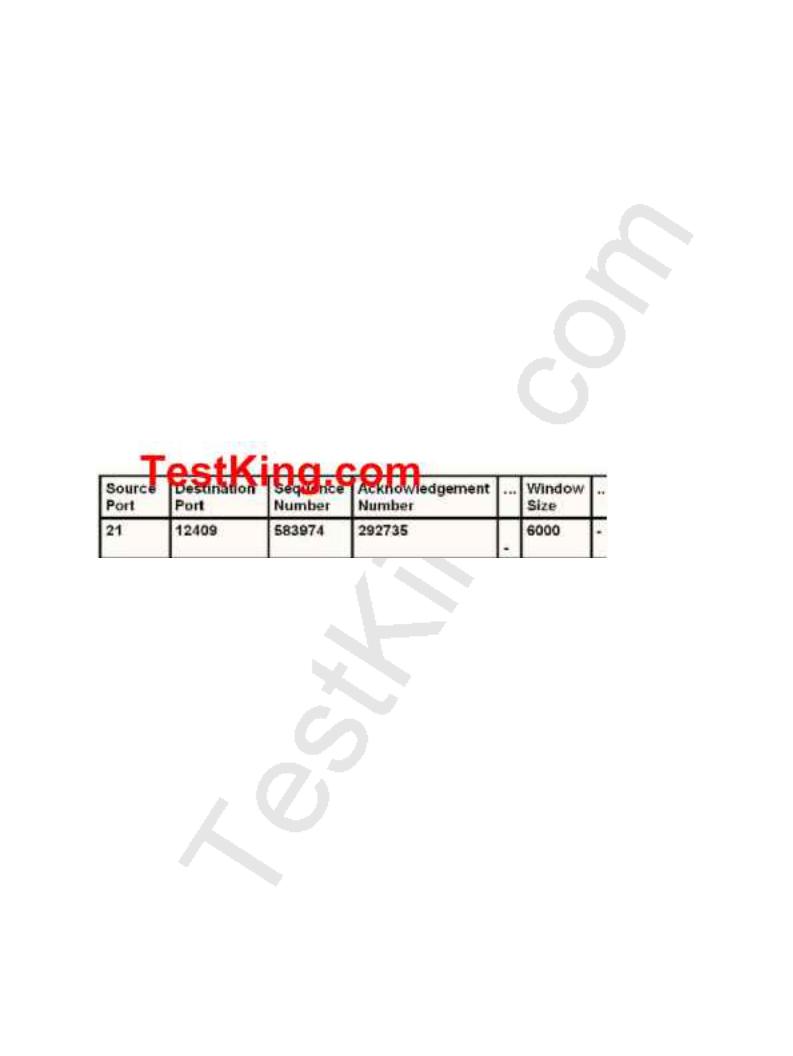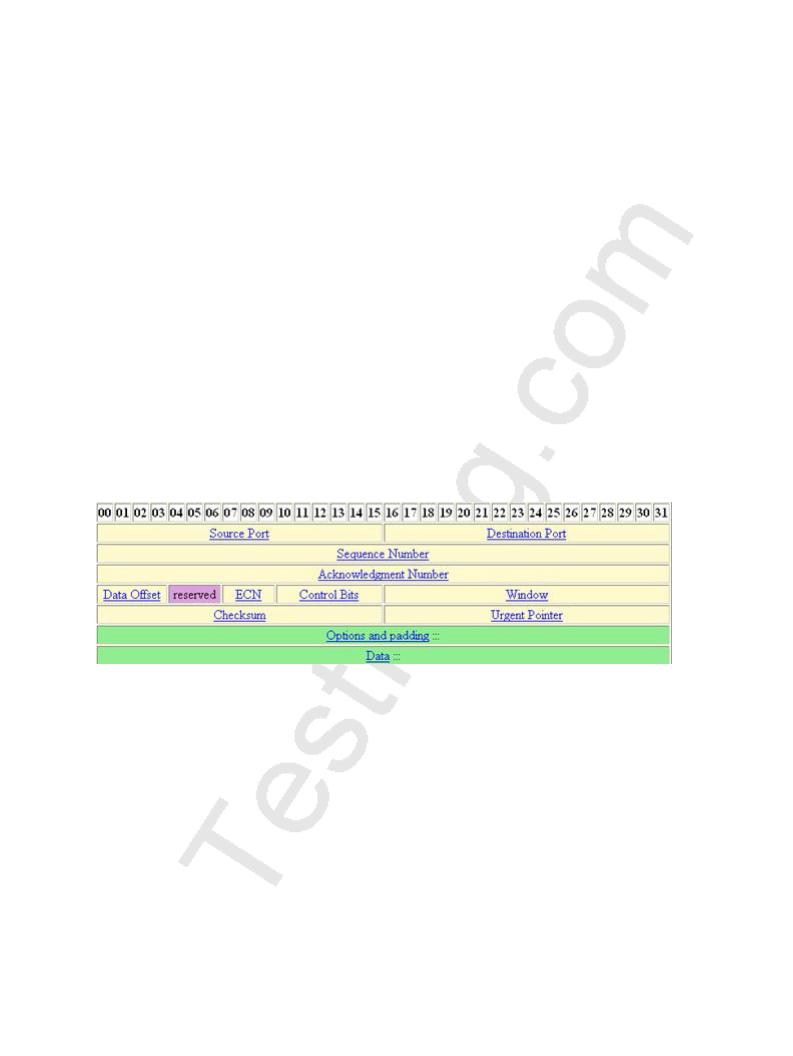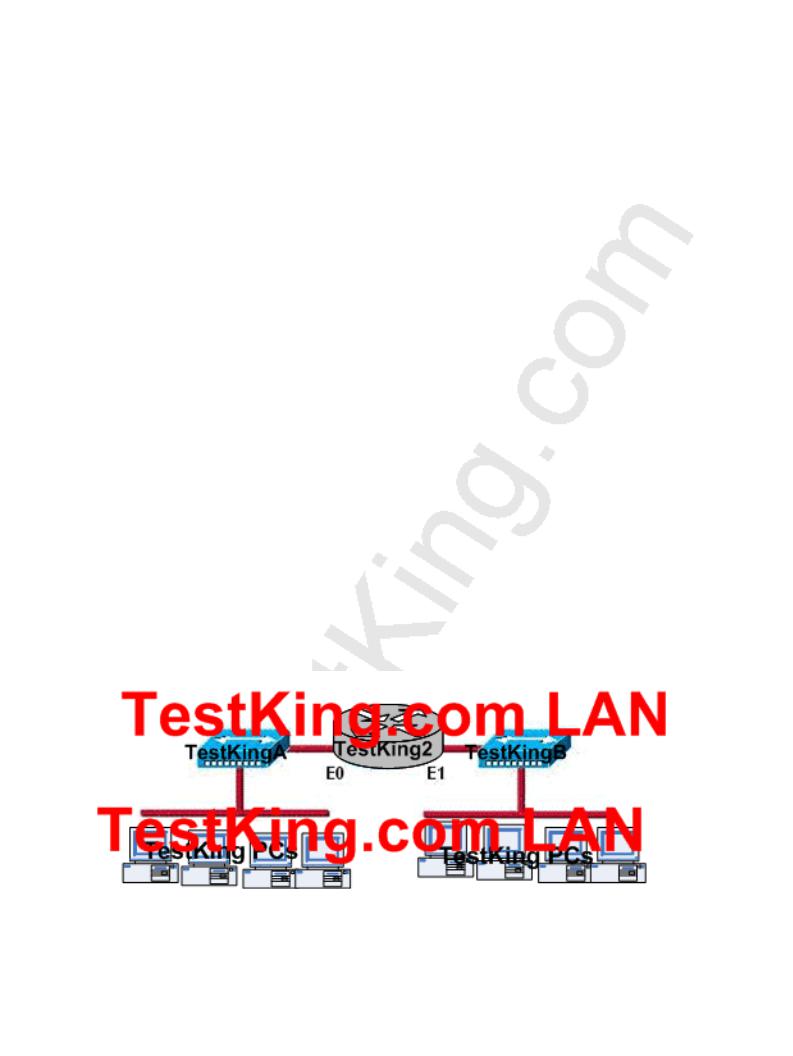
Testking_640-802_V13
.pdf
Answer: B, C
Explanation:
The OSI (Open System Interconnection) reference model was created as a reference point for communications devices. A layered approach is used to segment the entire telecommunications process into a series of smaller steps.
A is correct because it encourages a level of standardization by encouraging that functions be compared to known layers. D is also correct because it allows engineers to focus on the development, refining, and perfection of simpler components.
QUESTION NO: 2
You need to describe the various types of flow control to your co-workers. Which of the following are types of flow control that can be used in a network? (Choose three)
A.Congestion avoidance
B.Windowing
C.Cut-through
D.Buffering
E.Load Balacing
F.Fast Forward
Answer: A, B, D
QUESTION NO: 3
Which of the protocols below use TCP at the transport layer? (Select four)
A.TFTP
B.SMTP
C.SNMP
D.FTP
E.HTTP
F.HTTPS
Answer: B, D, E, F
Leading the way in IT testing and certification tools, www.testking.com
- 31 -

Explanation:
SMTP (Simple Mail Transfer Profile for email), FTP (File Transfer Protocol), and HTTP/HTTPS (Hyper Text Transfer Protocol for internet) all use TCP because of the reliable delivery mechanism. SMTP uses TCP port 25, FTP uses TCP ports 20 and 21, HTTP uses TCP port 80, and HTTPS uses TCP port 443.
Incorrect Answers:
A, C: SNMP and TFTP use UDP as the transport mechanism. Generally speaking, protocols that use the keywords "trivial" or "simple" uses UDP, since connectionless, best effort delivery mechanism usually suffice.
Reference: CCNA Self-Study CCNA INTRO exam certification Guide (Cisco Press, ISBN 1-58720-094-5) Page 163.
QUESTION NO: 4
Exhibit:
The exhibit above displays the partial contents of an encapsulation header.
Which of the following are true of the network traffic represented in this diagram? (Select three)
A.This is a UDP header
B.This is an OSI layer 4 header.
C.This is traffic from an FTP server.
D.This is traffic from an Telnet client.
E.The last PDU received in this session had a sequence number of 292735.
Answer: B, C, E Explanation:
As the header contains the sequence number and ACK number fields, it represents a TCP header. Choice B is correct as TCP works on Layer 4 i.e. Transport Layer.
Source Port mentioned in the header is 21 which indicate it is FTP Traffic because FTP uses port 20 and 21 for data and control. So choice C is correct.
Leading the way in IT testing and certification tools, www.testking.com
- 32 -

The acknowledgment number refers to the sequence number of the last PDU received, which is 292735, making choice E also correct.
QUESTION NO: 5
Which fields are included in the TCP header? (Choose three).
A.Source Port
B.Acknowledgement Number
C.Request Number
D.Destination Address
E.Window
F.Data
Answer: A, B, E
Explanation:
TCP header:
Source Port: 16 bits. Destination Port: 16 bits. Sequence Number: 32 bits.
The sequence number of the first data byte in this segment. If the SYN bit is set, the sequence number is the initial sequence number and the first data byte is initial sequence number + 1.
Acknowledgment Number: 32 bits.
If the ACK bit is set, this field contains the value of the next sequence number the sender of the segment is expecting to receive. Once a connection is established this is always sent.
Leading the way in IT testing and certification tools, www.testking.com
- 33 -

Data Offset: 4 bits.
The number of 32-bit words in the TCP header. This indicates where the data begins. The length of the TCP header is always a multiple of 32 bits.
Reserved: 3 bits.
Must be cleared to zero.
ECN, Explicit Congestion Notification: 3 bits. Added in RFC 3168.
Control Bits: 6 bits. Window: 16 bits, unsigned.
The number of data bytes beginning with the one indicated in the acknowledgment field which the sender of this segment is willing to accept.
Checksum: 16 bits.
This is computed as the 16-bit one's complement of the one's complement sum of a pseudo header of information from the IP header, the TCP header, and the data, padded as needed with zero bytes at the end to make a multiple of two bytes.
Urgent Pointer: 16 bits, unsigned.
If the URG bit is set, this field points to the sequence number of the last byte in a sequence of urgent data.
Options: 0 to 44 bytes.
Options occupy space at the end of the TCP header. All options are included in the checksum. An option may begin on any byte boundary. The TCP header must be padded with zeros to make the header length a multiple of 32 bits.
Data: Variable length.
QUESTION NO: 6
Acknowledgements, sequencing, and flow control are functions that are handled by which layer of the OSI model?
A.Layer 5
B.Layer 4
C.Layer 7
D.Layer 6
E.Layer 3
F.Layer 2
G.Layer 1
Answer: B
Leading the way in IT testing and certification tools, www.testking.com
- 34 -

QUESTION NO: 7
A receiving host has failed to receive all of the segments that it should acknowledge. What can the host do to improve the reliability of this communication session?
A.Start a new session using UDP
B.Obtain a new IP address from the DHCP server
C.Use a different source port for the session
D.Decrease the sequence number
E.Decrease the window size
Answer: E Explanation:
A TCP window the amount of outstanding (unacknowledged by the recipient) data a sender can send on a particular connection before it gets an acknowledgment back from the receiver that it has gotten some of it.
For example if a pair of hosts are talking over a TCP connection that has a TCP window size of 64 KB (kilobytes), the sender can only send 64 KB of data and then it must stop and wait for an acknowledgment from the receiver that some or all of the data has been received. If the receiver acknowledges that all the data has been received then the sender is free to send another 64 KB.
One way to improve the reliability of the TCP connection is to reduce the window size that the receiver needs to receive before sending an acknowledgement. However, this will reduce throughput as more segments and acknowledgements will need to be sent in order to transfer the same amount of data.
QUESTION NO: 8
You have set up an Internet based FTP server, where people can upload and download files. In terms of the OSI model, what is the highest layer used during the FTP sessions.
A.Application
B.Presentation
C.Session
D.Transport
E.Internet
F.Data Link
G.Physical
Leading the way in IT testing and certification tools, www.testking.com
- 35 -

Answer: A Explanation:
The application layer is the highest layer (layer 7) of the OSI model, and is reserved for end user applications. Since FTP is itself an application, layer 7 is the highest layer used.
Incorrect Answers:
B, C, D, E, F, G. In any given FTP session, all of these layers will be used at some point but they are incorrect because the question asked for the highest layer used by FTP.
QUESTION NO: 9
ICMP is often used in troubleshooting and verifying network. What statements are true regarding ICMP packets? (Choose two)
A.They acknowledge receipt of TCP segments.
B.They guarantee datagram delivery.
C.They can provide hosts with information about network problems.
D.They are encapsulated within IP datagrams.
E.They are encapsulated within UDP datagrams.
F.They are encapsulated within TCP datagrams.
Answer: C, D
Explanation:
ping may be used to find out whether the local machines are connected to the network or whether a remote site is reachable. This tool is a common network tool for determining the network connectivity which uses ICMP protocol instead of TCP/IP and UDP/IP. This protocol is usually associated with the network management tools which provide network information to network administrators, such as ping and traceroute (the later also uses the UDP/IP protocol).
ICMP is quite different from the TCP/IP and UDP/IP protocols. No source and destination ports are included in its packets. Therefore, usual packet-filtering rules for TCP/IP and UDP/IP are not applicable. Fortunately, a special "signature" known as the packet's Message type is included for denoting the purposes of the ICMP packet. Most commonly used message types are namely, 0, 3, 4, 5, 8, 11, and 12 which represent echo reply, destination unreachable, source quench, redirect, echo request, time exceeded, and parameter problem respectively.
In the ping service, after receiving the ICMP "echo request" packet from the source location, the destination
Incorrect Answers
Leading the way in IT testing and certification tools, www.testking.com
- 36 -

ICMP is an IP protocol so A and E are incorrect.
ICMP doesn't guarantee datagram delivery so B is wrong as well.
QUESTION NO: 10
Which of the following services use TCP? (Choose three)
A.DHCP
B.SMTP
C.SNMP
D.FTP
E.HTTP
F.TFTP
Answer: B, D, E Explanation:
TCP (Transmission Control Protocol) is a reliable mechanism for data delivery. SMTP, FTP and HTTP services use TCP via ports 25, 20/21, and 80, respectively.
QUESTION NO: 11
Which of the following are types of flow control? (Choose three)
A.Buffering
B.Cut-through
C.Windowing
D.Congestion avoidance
E.Load balancing
Answer: A, C, D Explanation:
Data transmission flow control occurs at layer 4 with the help of buffering, windowing and congestion avoidance.
Reference: CCNA Cisco Certified Network Associate Study Guide, 5th Edition, Todd Lammle, chapter 1, page 17.
Leading the way in IT testing and certification tools, www.testking.com
- 37 -

QUESTION NO: 12
Which Layer 4 protocol is used for a Telnet connection between two TestKing routers?
A.IP
B.ICMP
C.DNS
D.TCP
E.UDP
F.RTP
Answer: D Explanation:
TCP is a reliable connection-oriented protocol. TCP uses acknowledgments, sequencing, and flow control to ensure reliability. Telnet uses TCP port 23.
QUESTION NO: 13
FTP, Telnet, DNS, and SMTP are all protocols being used in the TestKing network. Of these, which uses both TCP and UDP ports?
A.Telnet
B.FTP
C.DNS
D.SMTP
E.None of the above
Answer: C Explanation:
The following port numbers for the protocols listed above are as follows:
FTP: TCP Port 20 and 21
SMTP: TCP Port 25
Telnet: TCP Port 23
DNS: both TCP and UDP Port 53
Leading the way in IT testing and certification tools, www.testking.com
- 38 -

Section 6: Describe the impact of applications (Voice Over IP and Video Over IP) on a network (2 questions)
QUESTION NO: 1
TestKing is installing IP phones in a new office. The phones and office computers connect to the same device. To ensure maximum throughout for the phone data sessions, the company needs to make sure that the phone traffic is on a different network from that of the office computer data traffic. What is the best network device to which to directly connect the phones and computers and what technology should be implemented on this device? (Choose two)
A.VLAN
B.Subinterface
C.STP
D.Hub
E.Switch
F.Router
G.Wireless Access Point
H.VTP
Answer: A, E
QUESTION NO: 2
The corporate head office of TestKing has a teleconferencing system that uses VOIP (voice over IP) technology. This system uses UDP as the transport for the data transmissions. If these UDP datagrams arrive at their destination out of sequence, what will happen?
A.UDP will send an ICMP Information Request to the source host.
B.UDP will pass the information in the datagrams up to the next OSI layer in the order that they arrive.
C.UDP will drop the datagrams.
D.UDP will use the sequence numbers in the datagram headers to reassemble the data in the correct order.
Leading the way in IT testing and certification tools, www.testking.com
- 39 -

E. UDP will not acknowledge the datagrams and wait for a retransmission of the datagrams.
Answer: B Explanation:
VOIP systems utilize UDP because it is faster and uses less overhead. In addition, the reliable transport mechanism used in TCP is useless to VOIP because if a packet gets dropped and needs to be resent, it will be already too late.
UDP provides a service for applications to exchange messages. Unlike TCP, UDP is connectionless and provides no reliability, no windowing, and no reordering of the received data. However, UDP provides some functions of TCP , such as data transfer, segmentation, and multiplexing using port numbers, and it does so with fewer bytes of overhead and with less processing required. UDP data transfer differs from TCP data transfer in that no reordering or recovery is accomplished. Applications that use UDP are tolerant of lost data, or they have some application mechanism to recover data loss. Reference: CCNA Self-Study CCNA INTRO exam certification Guide (Cisco Press, ISBN 1-58720-094-5) Page 161.
Section 7: Interpret network diagrams (7 questions)
QUESTION NO: 1
Part of the TestKing network is shown below:
Leading the way in IT testing and certification tools, www.testking.com
- 40 -
